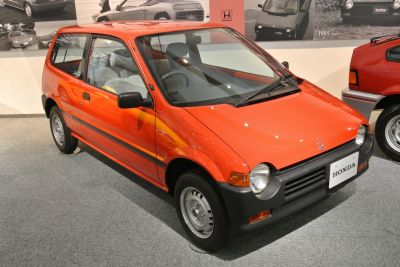 1987 Daihatsu Leeza Dimensions, Size & Specs
1987 Daihatsu Leeza Dimensions, Size & SpecsMeasurements of the 1987 Daihatsu Leeza, engineered for optimal performance and comfort
| Dimensions | |
|---|---|
| Length: | 3295 mm129.7 in10.8 ft |
| Width: | 1395 mm54.9 in4.6 ft |
| Height: | 1335 mm52.6 in4.4 ft |
| Weight Specifications | |
| Curb Weight: | 640 kg1411 lbs |
| Tire Specifications | |
| Rims Size: |
|
| Tire Size: |
|
The Daihatsu Leeza, produced between 1986 and 1994, is a compact hatchback designed to cater to urban drivers seeking an efficient and maneuverable vehicle. Measuring just 3295 mm (approximately 129.7 inches) in length, 1395 mm (about 54.9 inches) in width, and 1335 mm (52.6 inches) in height, the Leeza underscores compactness that is ideal for city environments and tight parking spaces. This small footprint contributes to its ease of driving and parking in crowded urban areas. The weight of the Leeza is notably light at 640 kg (around 1411 lbs), which supports fuel efficiency and nimble handling. Equipped with 12-inch rims paired with 145/70 R12 S tires, the car balances ride comfort with road grip, complementing its compact size and offering a stable driving experience. The Daihatsu Leeza exemplifies a practical hatchback from the late 1980s to early 1990s, combining lightweight construction, compact dimensions, and efficient use of space, making it an excellent choice for drivers valuing economy and ease of mobility in urban settings.
Discover the standout features that make the 1987 Daihatsu Leeza a leader in its class
Have a question? Please check our knowledgebase first.
The Daihatsu Leeza from the 1987 generation measures 3295 mm (129.7 inches) in length, 1395 mm (54.9 inches) in width, and 1335 mm (52.6 inches) in height. These compact dimensions reflect its design as a small city hatchback, making it highly maneuverable and suitable for tight urban environments. Its relatively low height contributes to a lower center of gravity, which can help vehicle stability while maintaining a compact profile.
The Daihatsu Leeza has a curb weight of approximately 640 kg (about 1411 lbs). This makes it a notably lightweight vehicle, especially compared to many other hatchbacks from the late 1980s, which often weighed more than 800 kg. The light curb weight contributes to better fuel efficiency and ease of handling, enhancing the Leeza's appeal as an economical city car.
The Daihatsu Leeza comes equipped with 12-inch rims paired with tires sized 145/70 R12 S. Smaller rim sizes like 12 inches aid in improving ride comfort and contribute to the vehicle's light handling characteristics. The 145 mm tire width combined with a 70% profile helps balance traction and cushioning over uneven surfaces, making it well-suited for urban driving conditions typical during its production years.
Yes, the Daihatsu Leeza’s compact dimensions of 3295 mm (129.7 inches) in length, 1395 mm (54.9 inches) in width, and 1335 mm (52.6 inches) in height allow it to fit comfortably into a standard residential garage. Most single-car garages tend to accommodate vehicles up to roughly 5400 mm (213 inches) long and 2400 mm (94 inches) wide, so the Leeza’s small footprint makes parking and storage easy even in limited spaces.
The Daihatsu Leeza, produced from 1986 to 1994, was essentially a unique nameplate without a direct predecessor bearing the same model. However, compared to earlier small Daihatsu hatchbacks and kei cars like the Daihatsu Mira, the Leeza was slightly longer and wider, offering a more spacious interior and improved comfort while maintaining a lightweight and compact profile, which kept it versatile for city driving.
At 1395 mm (54.9 inches) wide and 1335 mm (52.6 inches) tall, the Daihatsu Leeza is narrower and slightly lower than many contemporaneous hatchbacks, such as the Suzuki Alto or Honda City. This narrower and lower stance helped the Leeza be more agile in tight city streets, though it might offer less shoulder room inside compared to slightly wider competitors. Its compact size contributed to its role as an economical and practical urban vehicle.
The Daihatsu Leeza was designed as a small hatchback optimized for urban use, typically seating four passengers comfortably with basic interior space. Given the compact exterior dimensions, the interior space prioritized efficient use with adequate legroom and headroom for a subcompact vehicle. Although less spacious than larger cars, it offered sufficient comfort for daily city commuting and short trips.
With a curb weight of only 640 kg (1411 lbs) and small dimensions, the Daihatsu Leeza was highly fuel-efficient—a key attribute for vehicles in its class during the late 80s and early 90s. The lightweight frame combined with smaller engine options typical of this model helped deliver excellent mileage, making it affordable to run and popular in urban areas where fuel costs and efficiency were major considerations.
The Daihatsu Leeza featured a practical, minimalistic hatchback design tailored for urban driving. Its compact shape optimized maneuverability, while the inclusion of 12-inch wheels balanced ride comfort with agile handling. The model prioritized simplicity and economy, with design elements focusing on efficient packaging, ease of maintenance, and maximized interior space within its small footprint.
Given its compact length of 3295 mm (129.7 inches), narrow width, and lightweight build, the Daihatsu Leeza excels in parking and maneuvering inside crowded city areas compared to larger hatchbacks or sedans. Its small size makes it easier to find parking in tight spots, navigate narrow streets, and execute U-turns or parallel parking with greater ease than bigger cars. It is a prime example of an efficient urban vehicle from the late 1980s.
Discover similar sized cars.

| Production: | 1985-2013 |
|---|---|
| Model Year: | 1983 |
| Length: | 3335 mm131.3 in |
| Width: | 1440 mm56.7 in |
| Height: | 1410 mm55.5 in |

| Production: | 1985-1996 |
|---|---|
| Model Year: | 1985 |
| Length: | 3295 mm129.7 in |
| Width: | 1395 mm54.9 in |
| Height: | 1350 mm53.1 in |
